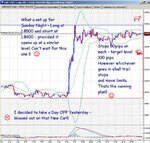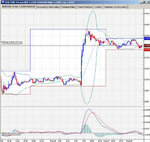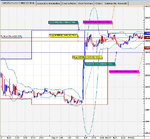Zenda
Well-known member
- Messages
- 491
- Likes
- 10
Fundamentals
Thought I would reproduce this - I think ita appropriate:-
Sustained dollar strength an unwelcome sight for corporate America
Recent sharp dollar appreciation has led many to wonder if the two-year downtrend in the greenback is finally over. If it is, this reversal could mark the beginning of the end of the good times for much of corporate America.
Indeed, the steep drop in the dollar has been a boon to American corporations selling products abroad. These companies have been the beneficiaries of the “translation” effect—changing revenues denominated in foreign currencies back into dollars. In many cases translation effects have had a significant effect on revenue growth. Witness some recent results:
Athletic footwear and apparel-maker Nike reported a nine percent increase in European revenues for the quarter ended November 30 last year. For the quarter, Europe accounted for over 30% of global revenues; were it not for the translation effect, revenue from Europe would actually have declined six percent.
Computer giant IBM announced that its Q4 2003 revenues were up nine percent, with nearly nine-tenths of the increase due to currency translation. In Europe/Middle East/Africa, revenues rose 20%, 17% of which was due to dollar weakness.
Manufacturing conglomerate 3M attributed more than a third of its 11.4% increase in Q3 2003 revenues to favourable currency movement.
Health care product maker Johnson & Johnson, which generates 40% of its total sales from abroad, reported that 60% of third quarter gains in international sales were the result of a weaker dollar.
Of course, when the dollar appreciates these translation effects become a drag on earnings. Should sustained dollar strength continue into 2004, the results for IBM, J&J and multinationals like them could be decidedly negative.
Fundamentals favour a lower dollar, at least for now
Despite the latest dollar rally, fundamentally conditions are in place for further greenback weakness. The dollar’s slide versus the major currencies in late 2003 was brought on in part by a US commitment to reflation. Historically low US interest rates and massive fiscal and trade deficits helped ensure that the dollar would be sold against its industrialized counterparts, many of whom are shifting to tighter monetary and fiscal policies. In addition:
The Fed appears to be firmly on hold. As seen by the Federal Reserve’s lowering of interest rates to 45-year lows, the central bank has committed itself to reflating an economy recovering from recession, falling prices and tepid business spending. With no signs of inflation pressures on the horizon, the Fed can afford to maintain short-term rates at the rock bottom 1% level for the foreseeable future. Indeed, the latest comments by Greenspan & Co. confirm that the rate-setting committee is firmly on hold. Market-watchers generally expect the Fed to begin raising rates during the second half of 2004 at the earliest, possibly holding off until early 2005.
Federal budget deficits are back in force. In addition to the Fed’s easy monetary policy, the federal government has likewise obliged with easy fiscal policy. After accumulating surpluses in excess of $200 billion in the late 1990’s, the federal government budget balance has rapidly deteriorated, the result of across the board tax cuts and increased spending on homeland security, defence and entitlements. A projected federal budget deficit approaching $400 billion is at a level far greater than any deficit run at any time over the past two decades.
American consumption continues to be financed from abroad. Americans continue to consume more than they produce, leading to large imbalances with several of its trading partners. While these imbalances are most pronounced with Asian countries like China and Japan, on an aggregate basis the US has run up trade deficits approaching 6% of GDP. To make this level of consumption possible, foreign investors finance this deficit through purchases of US debt, mainly Treasury bonds. While this arrangement has worked until now as mutually beneficial (Americans get to maintain high levels of consumption while foreign countries export their way to growth), over the longer term it not sustainable. At some point, foreigners will be unwilling to keep on buying US debt and will refuse to finance American consumption. In the extreme, the worst result would be a dollar crash that abruptly corrects these imbalances; however even if the dollar does not crash, it will almost certainly need to correct to a lower value over time.
Don’t bury the dollar just yet
While fundamentals imply a weaker dollar, the recent 8 big-figure moves down in EUR/USD and GBP/USD may suggest otherwise. The employment component of the latest ISM manufacturing survey intimates that long-awaited job creation in the US economy is just around the corner. A healthy labour market would signify the missing leg of the recovery and quickly begin to spark inflation and its attendant monetary tightening expectations.
Coupled with a massive repositioning of dollar shorts, it is this prospect of higher interest rates that has been driving the greenback ever higher. Should the labour market actually perform as advertised, renewed dollar strength could become the new status quo.
Dollar decline benefits companies with non-US revenues—and vice-versa
While the dollar falls, the companies that are set to profit are American multinationals such as Nike, IBM, 3M, and others like them. In particular, companies operating in regions where the dollar is weakest (e.g., Europe) have been in a position to benefit the most, as European revenues translate into relatively more dollars when the greenback depreciates.
In a setting of dollar strength however, the reverse is true—companies with revenue exposure in dollars, rather than euro or yen, become the most advantaged.
The take-away for investors? Given the possibility of renewed dollar strength, equity investors positioned for future dollar weakness may be well-advised to shift some exposure to non-US multinationals who earn revenues in dollars and translate them back into relatively weaker currencies
Acknowledge from FCXM
Thought I would reproduce this - I think ita appropriate:-
Sustained dollar strength an unwelcome sight for corporate America
Recent sharp dollar appreciation has led many to wonder if the two-year downtrend in the greenback is finally over. If it is, this reversal could mark the beginning of the end of the good times for much of corporate America.
Indeed, the steep drop in the dollar has been a boon to American corporations selling products abroad. These companies have been the beneficiaries of the “translation” effect—changing revenues denominated in foreign currencies back into dollars. In many cases translation effects have had a significant effect on revenue growth. Witness some recent results:
Athletic footwear and apparel-maker Nike reported a nine percent increase in European revenues for the quarter ended November 30 last year. For the quarter, Europe accounted for over 30% of global revenues; were it not for the translation effect, revenue from Europe would actually have declined six percent.
Computer giant IBM announced that its Q4 2003 revenues were up nine percent, with nearly nine-tenths of the increase due to currency translation. In Europe/Middle East/Africa, revenues rose 20%, 17% of which was due to dollar weakness.
Manufacturing conglomerate 3M attributed more than a third of its 11.4% increase in Q3 2003 revenues to favourable currency movement.
Health care product maker Johnson & Johnson, which generates 40% of its total sales from abroad, reported that 60% of third quarter gains in international sales were the result of a weaker dollar.
Of course, when the dollar appreciates these translation effects become a drag on earnings. Should sustained dollar strength continue into 2004, the results for IBM, J&J and multinationals like them could be decidedly negative.
Fundamentals favour a lower dollar, at least for now
Despite the latest dollar rally, fundamentally conditions are in place for further greenback weakness. The dollar’s slide versus the major currencies in late 2003 was brought on in part by a US commitment to reflation. Historically low US interest rates and massive fiscal and trade deficits helped ensure that the dollar would be sold against its industrialized counterparts, many of whom are shifting to tighter monetary and fiscal policies. In addition:
The Fed appears to be firmly on hold. As seen by the Federal Reserve’s lowering of interest rates to 45-year lows, the central bank has committed itself to reflating an economy recovering from recession, falling prices and tepid business spending. With no signs of inflation pressures on the horizon, the Fed can afford to maintain short-term rates at the rock bottom 1% level for the foreseeable future. Indeed, the latest comments by Greenspan & Co. confirm that the rate-setting committee is firmly on hold. Market-watchers generally expect the Fed to begin raising rates during the second half of 2004 at the earliest, possibly holding off until early 2005.
Federal budget deficits are back in force. In addition to the Fed’s easy monetary policy, the federal government has likewise obliged with easy fiscal policy. After accumulating surpluses in excess of $200 billion in the late 1990’s, the federal government budget balance has rapidly deteriorated, the result of across the board tax cuts and increased spending on homeland security, defence and entitlements. A projected federal budget deficit approaching $400 billion is at a level far greater than any deficit run at any time over the past two decades.
American consumption continues to be financed from abroad. Americans continue to consume more than they produce, leading to large imbalances with several of its trading partners. While these imbalances are most pronounced with Asian countries like China and Japan, on an aggregate basis the US has run up trade deficits approaching 6% of GDP. To make this level of consumption possible, foreign investors finance this deficit through purchases of US debt, mainly Treasury bonds. While this arrangement has worked until now as mutually beneficial (Americans get to maintain high levels of consumption while foreign countries export their way to growth), over the longer term it not sustainable. At some point, foreigners will be unwilling to keep on buying US debt and will refuse to finance American consumption. In the extreme, the worst result would be a dollar crash that abruptly corrects these imbalances; however even if the dollar does not crash, it will almost certainly need to correct to a lower value over time.
Don’t bury the dollar just yet
While fundamentals imply a weaker dollar, the recent 8 big-figure moves down in EUR/USD and GBP/USD may suggest otherwise. The employment component of the latest ISM manufacturing survey intimates that long-awaited job creation in the US economy is just around the corner. A healthy labour market would signify the missing leg of the recovery and quickly begin to spark inflation and its attendant monetary tightening expectations.
Coupled with a massive repositioning of dollar shorts, it is this prospect of higher interest rates that has been driving the greenback ever higher. Should the labour market actually perform as advertised, renewed dollar strength could become the new status quo.
Dollar decline benefits companies with non-US revenues—and vice-versa
While the dollar falls, the companies that are set to profit are American multinationals such as Nike, IBM, 3M, and others like them. In particular, companies operating in regions where the dollar is weakest (e.g., Europe) have been in a position to benefit the most, as European revenues translate into relatively more dollars when the greenback depreciates.
In a setting of dollar strength however, the reverse is true—companies with revenue exposure in dollars, rather than euro or yen, become the most advantaged.
The take-away for investors? Given the possibility of renewed dollar strength, equity investors positioned for future dollar weakness may be well-advised to shift some exposure to non-US multinationals who earn revenues in dollars and translate them back into relatively weaker currencies
Acknowledge from FCXM



